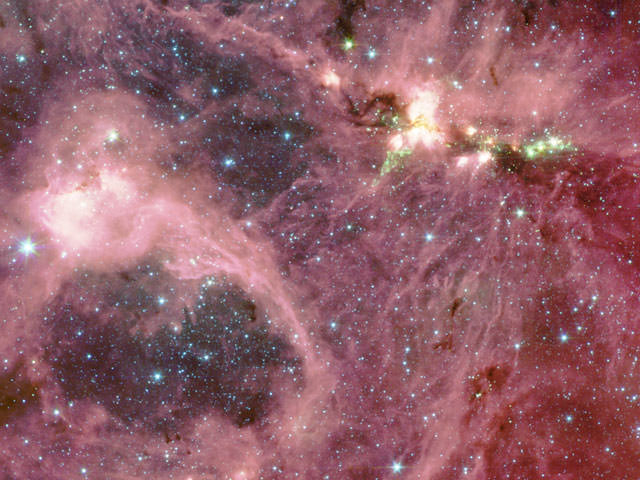[/caption]
Astronomers have glimpsed into the birth of a star, and have seen what could be the youngest known star at the very moment it is being born. “It’s very difficult to detect objects in this phase of star formation, because they are very short-lived and they emit very little light,” said Xuepeng Chen, from Yale University and lead author of a new paper. Not yet fully developed into a true star, the object is in the earliest stages of star formation and has just begun pulling in matter from a surrounding envelope of gas and dust. The team detected the faint light emitted by the nearby dust.
Using the Submillimeter Array in Hawaii and the Spitzer Space Telescope, the astronomers studied L1448-IRS2E, located in the Perseus star-forming region, about 800 light years away within our Milky Way galaxy.
Stars form out of large, cold, dense regions of gas and dust called molecular clouds, which exist throughout the galaxy. Astronomers think L1448-IRS2E is in between the prestellar phase, when a particularly dense region of a molecular cloud first begins to clump together, and the protostar phase, when gravity has pulled enough material together to form a dense, hot core out of the surrounding envelope.
Most protostars are between one to 10 times as luminous as the Sun, with large dust envelopes that glow at infrared wavelengths. Because L1448-IRS2E is less than one tenth as luminous as the Sun, the team believes the object is too dim to be considered a true protostar. Yet they also discovered that the object is ejecting streams of high-velocity gas from its center, confirming that some sort of preliminary mass has already formed and the object has developed beyond the prestellar phase. This kind of outflow is seen in protostars (as a result of the magnetic field surrounding the forming star), but has not been seen at such an early stage until now.
The team hopes to use the new Herchel space telescope, launched last May, to look for more of these objects caught between the earliest stages of star formation so they can better understand how stars grow and evolve. “Stars are defined by their mass, but we still don’t know at what stage of the formation process a star acquires most of its mass,” said Héctor Arce, also from Yale. “This is one of the big questions driving our work.”
Other authors of the paper include Qizhou Zhang and Tyler Bourke of the Harvard-Smithsonian Center for Astrophysics; and Ralf Launhardt, Markus Schmalzl and Thomas Henning of the Max Planck Institute for Astronomy.
The new study appears in the current issue of the Astrophysical Journal.
Read the team’s paper here.
Source: Yale University


This is really fascinating, because the outflow is not only due to magnetic fields, but especially related to accretion (well, at least in my opinion 😉 ). Another hint that stars, indeed, grow by accretion. And maybe a good start to begin research on a good theory of accretion and jets, because a growing star should be a non-relativistic and hopefully simpler case to study than, say, Active Galaxies. And accretion and jets are not very well understood.
Btw: Is there an arxiv preprint? Because you have to pay for the paper 😉
Here let me google that for you
http://tinyurl.com/29b3hy9
Dr Flimmer:
“L1448 IRS2E: A candidate first hydrostatic core” is available here: http://arxiv.org/pdf/1004.2443v1
Seems there’s a lot of interest in accretion and jets these days, perhaps because of the ubiquity of the phenomenon in our universe and our lack of knowledge of the same.
[sarcasm]
MAGNETIC FIELDS ARE ONLY CAUSED BY ELECTRIC CURRENTS!!!1!1!!1! 😛
[/sarcasm]
Excuse me for the above comment… it’s late (0510 UTC), I’ve been watching the footie (World Cup), and I’ve had too much beer!
Isn’t this the first glimpse of a ‘star’ on the Hayashi-Henyey track? I can remember there was much speculation 30-odd years ago about how astronomers would detect something this young and what it would look like. Good to see this kind of progress during ones life.
Thanks, guys! 😉
IIRC, the Hayashi-track was the very brief turn from a T Tauri star to a real star, that is to say, the core begins to burn hydrogen. So, since this star here is way before the T Tauri state, it also very far away from the Hayashi-track. (Again, iirc!)
@ Ivan3man
[darth vader voice]
Apologies accepted, Captain Needa!
[/darth vader voice]
😉
Btw: I will be in England when the final of the World Cup takes place. So I have to celebrate Germany’s winning in your country…… 😉 (this is written a few hours before Germany’s second game…)
@ DrFlimmer
Schade… Ref had a fetish for yellow.
Wow that is truly amazing is it not?
Lou
http://www.feds-logging.at.tc
DrFlimmer:
What?! After Germany losing 1 – 0 to Serbia? I would suggest that you don’t count your chickens before they have hatched! 😉